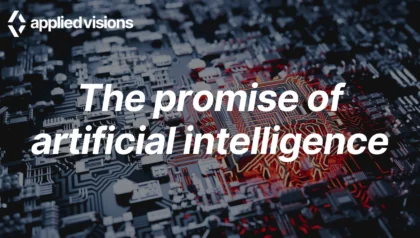
Blockchain has been described as a “new paradigm for the way information is shared.” Many companies are racing to see how they can harness this new technology in a profitable way.
But an old adage comes to mind: Look before you leap. While you don’t want to miss out on the benefits blockchain can bring to your business, this is still a relatively new technology. You don’t want to make a bad bet. Our goal with this article is to give you a good manager-level understanding of what the technology is, what it can do, and how it can potentially help your business achieve new levels of success.
Blockchain 101: What is it?
Given the way this topic has been presented in the media, one can be forgiven for thinking that blockchain and bitcoin are the same thing. They are related, but they are not the same. Blockchain was developed as part of the creation of bitcoin – it provides the underlying mechanism to securely keep track of the cryptocurrency. But it has significant utility beyond this.
Blockchain is a secure, distributed, electronic ledger. The ledger can be shared openly among different users, and it creates an unalterable record of each user’s transactions. Each transaction – called a “block” – is timestamped and linked to a specific participant. As transactions build upon each other, they are linked together, forming a “chain.”
Data cannot be erased or changed once in the blockchain system. A high level of security is built in, and it is self-policing in nature. Blockchain can also be programmed to initiate transactions automatically, adding a layer of efficiency.
Blockchains can be either public or private, with private blockchains only being accessible to a specific group of participants. Each individual on a blockchain has access to the entire database – in other words, ownership is shared equally among all parties.
The technology is ideal for such things as record-keeping and auditing, given its transparency and security, but it can be used to track many things – items on containers or ships, and all sorts of transactions. While we generally think of transactions in terms of currencies, this definition can be expanded to include things such as real estate transactions and processes, as well as steps in a formal contract-review process.
Think about purchasing a house. During the buying process, you pay a title company to search public records to verify the property’s chain of ownership to ensure it is free of liens. Blockchain could be used to capture that same property history so buyers would know the exact ownership history at any moment in time and without question, streamlining the process.
While nothing can claim to be “unhackable,” it is infinitely harder to hack a blockchain because to alter any one block would require that the entire chain containing that block be altered. This means every node in the network would have to be hacked, which would involve hundreds, thousands, or even millions of computers. A daunting task, to say the least. This makes blockchain one of the the most secure technologies devised to date. There are still, however, security issues to address, which will be discussed later on.
What does blockchain mean to my business?
The first question to ask yourself is, “Is my business amenable to being supported by a ledger?”
It’s important to expand your definition of what a ledger is. The traditional definition of “a book or collection of financial accounts of a particular type” is too restrictive. A more thoughtful look at your business may uncover ledger-based processes that you may not have originally considered.
Contracts may not seem ledger-based at first glance, but blockchain provides the ability to track every edit made to a contract as if each edit were a ledger transaction. You can trace, with certainty, every change made leading to the current state of the agreement. Taking this a step further, smart contracts can even be scripted so that things happen automatically once certain conditions are met. This can reduce or negate the need for middlemen and intermediaries, making transactions faster and cheaper.
Sound far-fetched? Two years ago, DocuSign and Visa demonstrated a proof-of-concept application that lets you lease a car, insure it, drive it away, and pay its operating expenses, all from a few controls in the car itself. This demonstration ties together DocuSign’s digital transaction management, Visa’s electronic payments, and Internet of Things connectivity by inserting the car into a blockchain and tracking everything else as transactions against that car. You can read about this application of the technology here.
As your understanding of blockchain grows, continually re-examine your business to see where you may be able to leverage this technology.
The most common industries diving into blockchain
Shipping, financial services, and healthcare are three industries embracing this technology, and they are excellent examples of how blockchain is starting to transform the business landscape.
- The shipping industry is using blockchain technology to track the progress of goods throughout the shipping process. This includes container status and customs documents, among other items. A great example of this is Maersk’s announcement in March 2017 that it was working with IBM to digitize the cross-border supply chain via blockchain.
- Financial services are seeing great efficiencies in payments, clearance, and settlements due to the instant data sharing and the removal of reconciliation and confirmation requirements that blockchain delivers. J.P. Morgan has created a vast blockchain payment network called the Interbank Information Network (IIN). The IIN will save time in cross-border payments by reducing the number of people required to respond to compliance and other inquiries during the process. The Royal Bank of Canada and the Australia and New Zealand Banking Group Ltd. have joined the IIN, further increasing the reach of this network.
- Mastercard established a blockchain network to add speed and security to payments. This network also leverages smart contract rules to reduce administrative tasks, further speeding up the transaction process.
- The currency exchange service KlickEx partnered with IBM to deploy a blockchain-based open source network for international exchange payments. The technology enabled KlickEx to eliminate batch processing of payments, which were causing hold-ups. The company is now able to provide a real-time system where payments happen immediately so more payments are processed per day, bringing in more business.
- Blockchain brings advances in electronic health records to the healthcare industry by creating a network where multiple parties can access and make updates to records. The security elements of blockchain ensure that only verified individuals or companies have access to the information. Patients can provide keys to authorized caregivers and other parties to give them access to their health records. Cryptography encrypts the contents of the blockchain to ensure the data cannot be read by unauthorized parties.
- IBM Watson Health and the U.S. FDA signed a two-year agreement in January 2017 to research how blockchain could be used to securely share patient data, ranging from electronic records to data from wearables. Blockchain technology provides a solution to secure data exchange in the healthcare industry.
- Mint Health is a new portable personal health record that gives patients increased control over their personal records. The mobile app is built with blockchain. It allows patients with chronic diseases to enter in vital signs and view their health history, empowering patients to take a more proactive role in their health.
The road to blockchain adoption
Blockchain’s role in how we do business is likely to follow a slow but steady trajectory. Changes beyond the technological realm are required for blockchain to fully take hold. Government and society will also need to change and adapt to this new way of doing business and exchanging information. For a deeper look at how blockchain technology may unfold over time, check out this in-depth analysis by the Harvard Business Review.
Forrester predicts that blockchain development will be gradual, and enterprises should be cautious when experimenting with the technology. Forrester notes a number of potential drawbacks to blockchain, including:
- Software bugs – Blockchain software is new. This makes bugs a real threat. You must be wary of where software is coming from. In one instance, a user was able to lockdown $300 million of cryptocurrency on Ethereum (a blockchain app platform) through a coding vulnerability in the multisignature wallets feature of the application.
- One size does not fit all – Blockchain is not a good fit for all kinds of transactional tasks. Transactions that include a lot of images would eventually get too large as the chain continues to grow, and would not be ideal for this technology.
- Security is still a concern – Developers must pay careful attention to potentially weak cryptography. Companies rushing into the technology may rely on algorithms for cryptography which are not well-tested. Cryptography plays a central role in blockchain security. Algorithms that deploy it must be strong and proven.
- Scalability – Every update to a blockchain must be processed by every node on the network (in the “chain”). This makes updates slower than traditional databases which can update in parallel.
- Confidentiality issues – Transparency is not always a good thing. Your application may benefit from creating sub-chains to protect sensitive data.
These issues should not deter you from blockchain. Explore the pros and cons before committing time and resources. Know what to be wary of. Be sure to properly vet any third parties offering services.
So you want to experiment with blockchain. Now what?
If you’re sold on blockchain and see how it can benefit your business, you may be wondering what to do next. There are a few challenges to address in terms of coding and some skills required within your team or from external resources.
There are some issues specific to blockchain coding that need to be addressed:
- Implementation of public blockchains is exposed to the public. Security is of paramount concern. This is no different than your public-facing web app: resources must be devoted to constantly assessing the security of your code, finding vulnerabilities, and addressing them promptly. This slows development down, but it is a necessary precaution – it will be a lot slower if you get hacked and have to shut your network down until you fix it.
- Your code must keep up with throughput demands and network capacity as the blockchain grows. The volume of information and overall size of the chain continues to grow as transactions are added.
- Some transactions can be done in parallel (at the same time). Others cannot. In our real estate example, there are certain steps that must be done in a certain order. They cannot be done in parallel. Your code must be versatile enough to handle both parallel and non-parallel transactions, while still maintaining optimal performance.
- All transactions must be coded in such a way that they are isolated from non-deterministic elements. Blockchain transactions must be deterministic – they must always behave in the same way – every single time to ensure the ledger is consistent across all nodes in the network. Smart contracts and transactions must be isolated from any elements that would result in an inconsistent result from one day to the next, or from one node in the network to the next. Timestamps are a good example: Timestamps fetched within the blockchain coding are non-deterministic because the code may be executed at different times on different nodes, yielding different results (timestamps). Timestamps that are inputs into the blockchain are deterministic – the same timestamp is reported in all instances.
There are several programming languages developers can use for blockchain app development, namely:
- C++
- Javascript
- Python
- Solidity
For further details on these coding languages and how to use them for blockchain source code development, click here.
Blockchain coding is complex, but the good news is businesses do not need to build it alone. There are several blockchain source code resources available which serve as an excellent starting point for companies wanting to experiment. Several cloud providers are offering blockchain as an enterprise service. Blockchain-as-a-Service (BaaS) enables companies to test out the new technology without the cost or risk of in-house resources. Some of the big players in this space are Microsoft, Oracle, and IBM’s Blockchain platform.
A big name in the blockchain space is Ethereum, – an open-source, decentralized app platform. It features smart contracts, and enables applications to run without downtime, fraud, or third-party interference. Ethereum is the basis of the cryptocurrency ether which is similar to bitcoin, but developers are also able to develop their own cryptocurrencies, as well as a wide variety of decentralized apps
IOTA is a new approach to blockchain. Each participant has a role in transaction validation. When a device makes a transaction, it has to validate two previous transactions. This makes IOTA a peer-to-peer network ideal for automating machine transactions. The IOTA architecture enables transactions to occur offline and to be validated in parallel – providing scalability previously unattainable with blockchain. IOTA provides a framework for building systems, including IoT systems, around blockchain. It includes, among others, services for interoperability, resource sharing, data security, and zero-fee micro-transactions. This means even the smallest of payments can be made without fees, opening up new possibilities for currency transactions to drive your business.
The Linux Foundation is another valuable resource providing tools for building blockchain collaboration networks through its Hyperledger project. It is an open-source collaborative software effort that hosts five different business blockchain frameworks to assist cross-industry blockchain technologies:
- Fabric – Foundation for developing blockchain applications.
- Sawtooth – Modular platform for scalable distributed ledgers.
- Iroha – Simple framework for infrastructure projects needing distributed ledgers.
- Burrow – Modular blockchain client for smart contract applications.
- Indy – A distributed ledger with features for working with digital identities.
We are already seeing a glimpse of how blockchain can transform the business landscape, but these changes will not happen overnight. You will need to re-evaluate your processes and strategies. And you will need to decide if blockchain is truly the right fit for your business. The first step in making that decision is a basic understanding in blockchain itself. Now that you have that knowledge, you can make informed decisions about what blockchain can do for your business.


